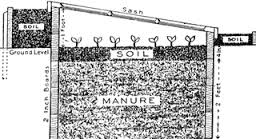A hotbed is a glass- covered container which is heated by the lower digged in decomposing manure. Here you can sow vegetables already early. Dig a hole 40 to 80 cm deep. If you have a lot of manure, you can make it deeper and therefore hotter. Fill the pit with (horse) manure, covered with 20 to 25 cm of soil.  Orient the tray to the spring sun. If it gets too hot you put the windows (fixed) open. Make sure they cannot be blown away.
Orient the tray to the spring sun. If it gets too hot you put the windows (fixed) open. Make sure they cannot be blown away.
With horse manure can be reached after a few weeks a soil temperature to about 30°C (and more), which then slowly decreases over eight weeks to about 20°C. With only straw is the initial temperature 15°C, and then increased to about 18°C. in eight weeks.
Use manure rather not directly in the garden. The roots of plants can burn. And you give microorganisms an opportunity to come back to you in a cycle. Let it digest first.
(A meiler (Compost heater) is a covered pile of wood that is carbon-charred (without oxygen) to charcoal, and baking ovens were also called meiler.)
A biomeiler is a compost heap from which heat is utilized (through a closed circuit) by a water spiral lying in it. Bacteria break down wood chips (among other things.) until it becomes compost.
This produces a lot of heat (up to 60-65 degrees C).
A large biomeier (Jean Pain Method) with fine wood chips (and manure) works for 1 to 1.5 years and can maintain an operational high temperature up to 9 months.With a heat exchanger it can be used in a home or storage tank. Do not expect miracles in our regions. 30 degrees in the secondary circuit would be feasible. Velt used to have such a spiral in Genk that was directly connected to a radiator in their room. It breaks the cold. It helps if you feed and build the meiler well, and insulate the outside with dry material.
Moist areas in hay can ferment intensively, which results in self-heating. Flammable gases may be released from 55 ° C. Hay itself ignited at a temperature of 225 - 240 ° C. Above 60-70 degrees the biological process changes and chemical heating occurs. Carbon is converted into carbon dioxide, the temperature can quickly rise to above 100 degrees. From 85 ° C (and certainly from 100 ° C) spontaneous combustion can ignite the hay on the outside, with sufficient air supply.
